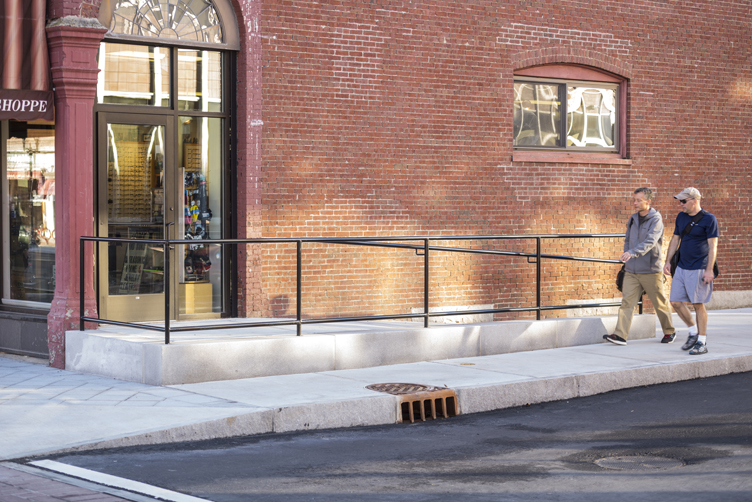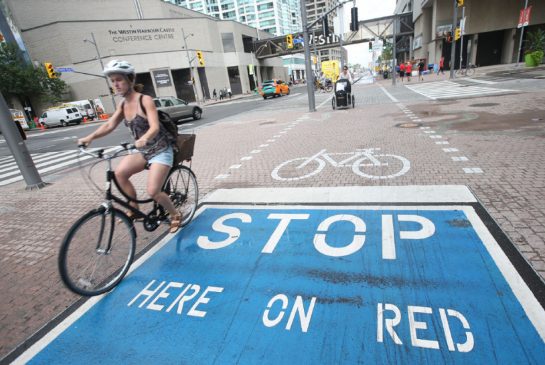Breaking Down Barriers
Making streets, sidewalks safer for people with limited mobility

City of Concord
Concord, New Hampshire eliminated its double-step curbs, reduced travel lanes and added handicapped parking to make
Main Street more accessible.
Before the City of Concord renovated its Main Street, residents and visitors had to walk up two steps to access the restaurants and storefronts along the western side of the road.
New Hampshire’s capital city eliminated the double-step curbs as part of a larger downtown complete streets project, which aimed to improve access for people with disabilities and spur economic development. The city also created additional handicapped parking spaces and converted a portion of the Main Street from four lanes to two lanes and added a six-foot center median to slow vehicles and reduce the distance for pedestrians crossing the busy street.
“We call Concord’s Main Street New Hampshire’s Main Street, and Concord’s downtown New Hampshire’s downtown,” Concord City Engineer Ed Roberge said. “Making Main Street more accessible is something in which the city takes great pride.”
Concord’s project is just one example of ways communities are trying to make streets and sidewalks more accessible for senior citizens and people with physical disabilities. Across North America, cities are employing different tactics including removing lanes of traffic, adding rest benches with shade and medians with greenery, installing raised crosswalks to slow traffic, working with businesses to build ramps and eliminating obstacles in sidewalks.
These measures are necessary to help avoid injury and inconvenience to the 18.2 million or 7.5 percent of adults in the United States that have extreme difficulty walking or are unable to walk a quarter mile. As the country’s population ages, an increasing percentage of Americans with disabilities are 55 and older.
One factor driving good design is the adoption of complete streets policies, a national initiative being spearheaded by Smart Growth America, a Washington, D.C. non-profit organization. Complete streets is an approach that advocates for transportation projects being planned, maintained and designed so all users can access the roadway.
Emiko Atherton, director of the National Complete Streets Coalition, a Smart Growth program, said one of complete streets’ goals is to eliminate traffic fatalities.
“You can design away a lot of behavior,” she said.
Concord completed its Main Street complete streets project in fall 2016 and Roberge said the project has done more than just make the area more accessible.
“There are now opportunities for public art and new gathering spaces,” he said. “There have been very positive responses from people with disabilities and disability rights organizations. Even the downtown merchants’ vacancies have improved.”
Prior to 2014, the downtown had an 18 percent vacancy rate. That rate has dropped to 5 percent since the project was completed, he said.
There are several organizations that partner with Smart Growth America to train and educate local officials on incorporating complete streets into design plans. Among them is AARP, which represents retirees and advocates for well-maintained sidewalks to help reduce the risk of falls.
“As people age, they’re looking for very smooth surfaces on the sidewalk,” said Jana Lynott, senior policy advisor for AARP. “There’s often a tendency to plan for aesthetics. We can’t compromise their safety.”
Lynott said there are concerns about bricks, surfaces with different heights within a sidewalk and obstacles like trash cans in pedestrian walkways.
Kathy La Plante, senior program officer of National Main Street Center (NMSC), an organization devoted to preserving historic downtowns and neighborhoods, agrees that uneven surfaces in downtowns can be a concern.
“We advocate treating the crosswalks a little bit differently in giving them a smoother surface,” said La Plante. She added that communities can also raise a crosswalk, paint it, or use a stamped pavement to add texture. These treatments can slow down vehicular traffic and make the path safer for pedestrians.
Lynott said in addition, AARP seeks to ensure a harmonious use of space in places where people tend to congregate, such as bus stops.
“Bicyclists and skateboarders should not be allowed on sidewalks and in other pedestrian areas where there is a high density of people on foot,” she said. “Older adults often have a legitimate fear of falling. Sharing space with bicyclists and skateboarders can be intimidating and dangerous.”
Lynott said AARP has organized walking audits in communities across the United States to document obstacles to safe pedestrian travel for older adults. AARP volunteers watch street signals to determine whether the signals provide sufficient time for an older pedestrian to make it across a high traffic intersection.
“We also recommend installing park benches along sidewalks to give people a place to rest,” she said, adding it encourages opportunities for interaction. “This decreases social isolation. It makes for good people watching.”
La Plante said NSMC supports raised sidewalks and ramps to businesses that make it easier to get access to downtown storefronts. It’s an issue the City of Toronto is also working to address.

City of Toronto
The City of Toronto held an international design competition
to make Queens Quay, a two-way road, safer for pedestrians
and cyclists.Toronto must abide by the Accessibility for Ontarians with Disabilities Act (AODA), a provincial statute with language similar to that of the United States’ Americans with Disabilities Act (ADA). As part of this, businesses must ensure their establishments are handicapped-accessible.
Fiona Chapman, manager of pedestrian projects for the City of Toronto’s Transportation Services, said while businesses are well intentioned, their plans are sometimes flawed.
“Business owners are now installing structures to provide accessibility to people with disabilities, but they are putting in structures that are not up to code,” she said.
Toronto encourages business owners to follow regulations by requesting they submit drawings for accessibility structures. The city is also in the middle of developing an approach to installing handicapped-accessible structures where there is insufficient sidewalk space.
In addition to working with businesses, the city also must coordinate with the four community councils that govern the city and outlying neighborhoods and can recommend issues to the City Council. This has created a challenge for the city’s effort to install new sidewalks in communities where none exist.
“Many neighborhoods are designed without sidewalks because they were meant to have a more rural feel. In many situations, community members adamantly oppose sidewalks,” Chapman said. “Often the city staff bring matters to our community councils and we are not successful in getting the missing sidewalk built.”
While Toronto continues to push to install more sidewalks, some cities are grappling with how to manage their extensive sidewalk systems. In New York City, it’s a challenge to maintain a 5-foot clear path on all of them.
Quemuel Arroyo, ADA coordinator for the New York City Department of Transportation, said the city also searches for other ways to ensure the streets are safe for those with physical disabilities.
“We are piloting raised crosswalks with a flat top speed bump,” he said. “That forces motorists to reduce their speed as they’re coming into the crosswalk.”
The city also uses data from the New York Police Department and New York State Department of Motor Vehicles to identify corridors where there are safety concerns. Like Concord, New York City has reduced travel lanes, a strategy known as a road diet, to slow traffic and make the streets safer for pedestrians in problem areas.
One example of a road diet was a section of Broadway where NYC DOT saw excessive speeding by livery drivers.
“This area had three lanes of moving traffic,” Arroyo said. “We implemented a road diet that reduced one lane to a parking lane accompanied by two moving lanes with buffer zones added in.”
Another city grappling with how to handle its vast sidewalk network is Los Angeles. Over the next 30 years, the city will spend $1.4 billion on sidewalk improvements. The project is part of a settlement agreement from a 2013 lawsuit, Willits v. City of Los Angeles, in which the plaintiffs alleged the city violated the ADA because sidewalks were damaged and curb ramps were missing or inaccessible.
Stephen Simon, executive director of the city’s Department on Disability, said Los Angeles is now figuring out how and where to rebuild thousands of miles of sidewalk. The money must be used where plaintiffs are located.
“The repairs occur in areas close to them. If they move, they put a new request for repair in and get to the top of the list,” he said.

City of Fairbanks Public Works Department
Crews in Fairbanks, Alaska use plows and shovels to ensure streets and sidewalks are accessible following snow storms.
Weather also presents a challenge for accessibility. Rachel Beyerle, communications director for Easterseals’ transportation group, said plowing roads is often the priority. “Imagine if you’re in a wheelchair or an older adult and the snow is piled up on the sidewalk. We see people in wheelchairs using the street to travel. This creates a danger for them and drivers.”
Some cities have more snow to deal with than others, like Fairbanks, Alaska.
Jeff Jacobs, director of public works for Fairbanks, said the city has an extended winter season. His department is responsible for sanding and plowing more than 355 lane miles of road and 53 miles of sidewalks. That means that public works staff hand shovel handicapped-accessible sidewalk ramps and use an articulated sidewalk plow to remove snow, to ensure pedestrians with disabilities can get around.
“It is a balancing act between keeping roads and sidewalks open all winter long,” he said. “This summer, the city is utilizing a $50,000 grant to complete a sidewalk inventory city-wide. We anticipate using the data from this survey to focus on priorities for improving ADA compliance.”
Alicia Stevens, transportation planner for the Fairbanks Metropolitan Area Transportation System (FMATS), said the work doesn’t stop when the snow starts to melt in April. That’s when Fairbanks must begin repairing the many cracked and crumbling sidewalks. Stevens said FMATS has a sidewalk replacement program, for which agencies nominate areas in need of repair, and that sidewalk improvements are also considered anytime the agency does a road improvement.
Jessica Zimmer is a freelance writer based in California.